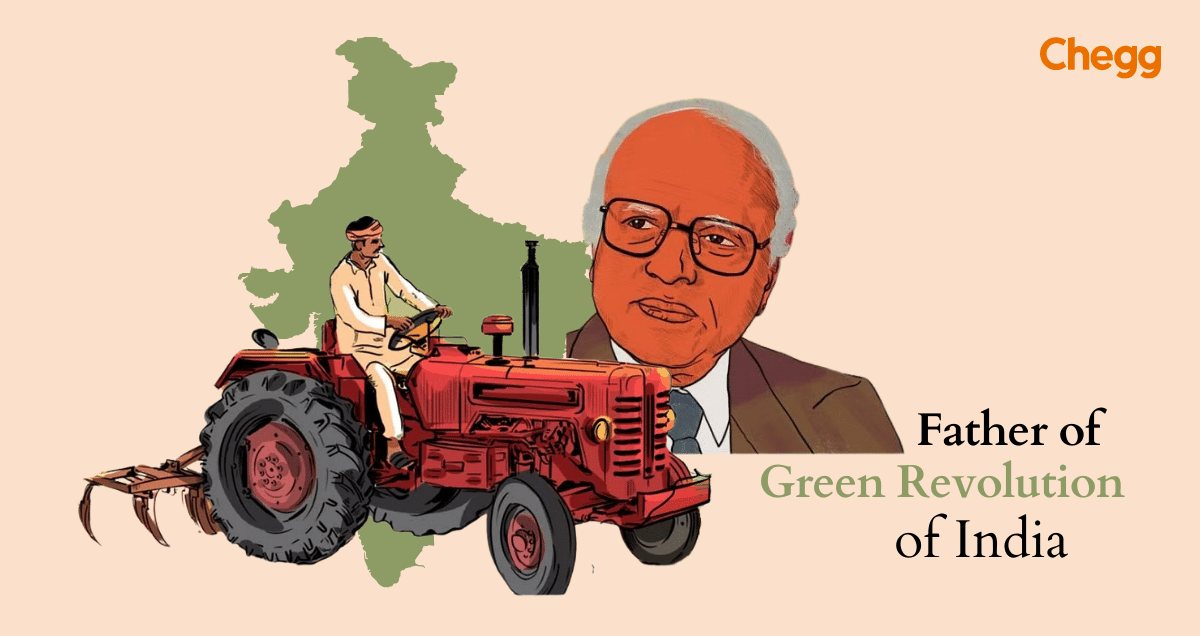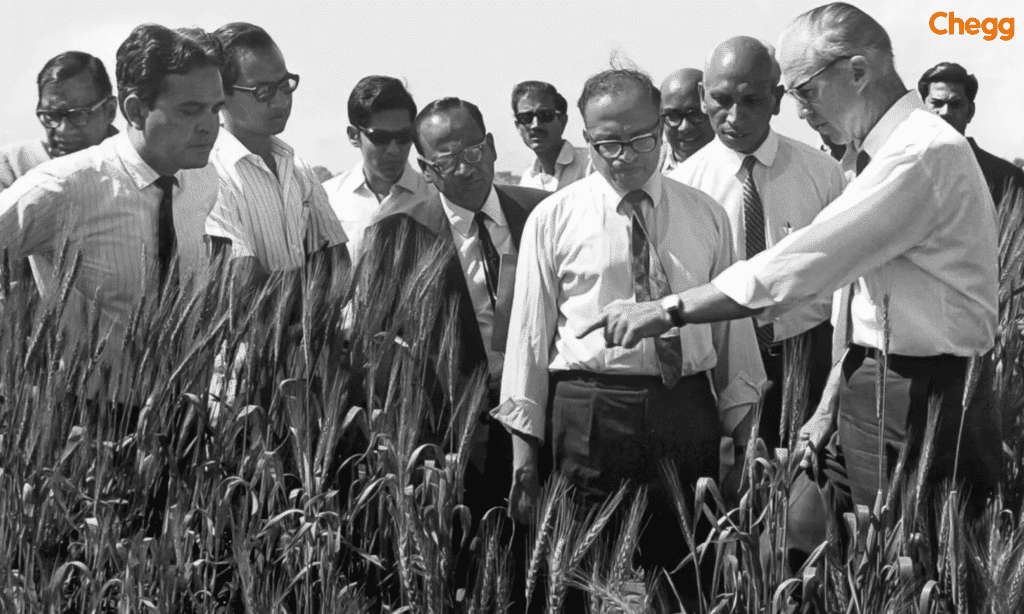
Quick Summary
Table of Contents
The Green Revolution was a major turning point in the history of Indian agriculture. It transformed the country from a food-deficient nation into one of the world’s largest agricultural producers. The driving force behind this remarkable transformation was Dr. M.S. Swaminathan, often referred to as the “Father of Green Revolution in India.” In this blog post, we will explore the life, contributions, and impact of Dr. Swaminathan, providing a comprehensive understanding of why he is celebrated as the Father of Green Revolution in India.

Let’s find out what is Green Revolution. The Green Revolution refers to a series of research, development, and technology transfer initiatives that occurred between the 1940s and the late 1960s. These initiatives significantly increased agricultural production worldwide, especially in developing countries like India. The revolution introduced high-yielding varieties of seeds, the use of chemical fertilizers and pesticides, and improved irrigation techniques.
Before the Green Revolution, India faced severe food shortages and was heavily dependent on food imports. The revolution not only helped India achieve self-sufficiency in food production but also improved the livelihoods of millions of farmers. It played a crucial role in preventing famines and ensuring food security.
Dr. Monkombu Sambasivan Swaminathan, born on August 7, 1925, in Kumbakonam, Tamil Nadu, is known as the Father of Green Revolution in India. He came from a family of farmers and was deeply influenced by his father, who was a surgeon and a social reformer. Dr. Swaminathan’s early exposure to the challenges faced by farmers inspired him to pursue a career in agricultural science.
Dr. Swaminathan completed his undergraduate studies in zoology at Maharaja’s College in Trivandrum and later obtained a degree in agricultural science from the Madras Agricultural College. He pursued his postgraduate studies at the Indian Agricultural Research Institute (IARI) in New Delhi and earned a Ph.D. in genetics from the University of Cambridge. His early research focused on the genetics of potatoes, but he soon shifted his focus to wheat and rice, which were crucial for India’s food security.
Dr. M. S. Swaminathan studied agriculture and genetics, becoming an expert in plant science. Father of the Green Revolution in India is a well-deserved title for Dr. Swaminathan. Here’s how his contributions made a significant difference:
The Green Revolution had a significant impact on India’s agricultural sector. Food production increased dramatically, leading to:

The most visible impact of the Green Revolution was the dramatic increase in food production. Between the 1960s and 1980s, India’s wheat production tripled, and rice production doubled. This surge in productivity helped India achieve self-sufficiency in food grains and significantly reduced the need for food imports.
The Green Revolution improved the livelihoods of millions of Indian farmers. Higher crop yields translated into increased income, enabling farmers to invest in better farming equipment, education, and healthcare. It also created employment opportunities in the agricultural sector and related industries.
The Green Revolution played a crucial role in enhancing food security in India. It ensured a stable supply of food grains, preventing famines and reducing malnutrition. The availability of surplus food also helped stabilize food prices, making staple foods more affordable for the population.
While the Green Revolution brought numerous benefits, it also posed environmental and social challenges. The intensive use of chemical fertilizers and pesticides led to soil degradation, water pollution, and loss of biodiversity. Additionally, the benefits of the Green Revolution were not evenly distributed, leading to disparities between large and small farmers.
In our last section, we talked about Dr. M. S. Swaminathan, the Father of the Green Revolution in India. The Green Revolution brought many good changes, but it also had some problems.
Critics say that the Green Revolution:
The Green Revolution, led by Dr. M. S. Swaminathan, changed Indian farming a lot. While it had challenges, it showed how science and innovation can help solve food problems. By learning from the past and using sustainable methods, we can make sure everyone has enough healthy food in the future.
Dr. M.S. Swaminathan’s work goes far beyond being the Father of the Green Revolution in India. His dedication to farming progress and making sure everyone has enough food has earned him many awards and led him to start an important research foundation. His ideas still shape farming policies in India and other places.
Dr. Swaminathan received many awards for his amazing work. Here are a few important ones:
These awards show how much Dr. Swaminathan contributed to agriculture.
Dr. Swaminathan’s work wasn’t just about the past. In 1988, he started the M. S. Swaminathan Research Foundation (MSSRF). This non-profit organization focuses on helping small and poor farmers with sustainable farming practices. The MSSRF works on:
The MSSRF continues Dr. Swaminathan’s work, aiming for a future where food security is achieved responsibly.
Dr. Swaminathan’s ideas have greatly influenced India’s farming policies. He advised the government on food security, sustainable farming, and farmers’ welfare. Some key policies he helped shape include:
His influence continues to inspire policymakers to create farming strategies that are productive, fair, and sustainable.
Dr. M.S. Swaminathan’s legacy is vast. Being the Father of the Green Revolution in India is just one part of his story. His dedication to science, sustainable practices, and helping farmers inspires many agricultural scientists and policymakers to work toward a future where food security and environmental health go together.
| Year | Award | Organization |
|---|---|---|
| 1967 | Padma Shri* | Government of India |
| 1971 | Ramon Magsaysay Award | Ramon Magsaysay Award Foundation, Philippines |
| 1972 | Padma Bhushan** | Government of India |
| 1986 | Albert Einstein World Award for Science | World Cultural Council, Mexico |
| 1987 | World Food Prize | World Food Prize Foundation, United States |
| 1989 | Padma Vibhushan*** | Government of India |
| 2000 | Indira Gandhi Prize for Peace, Disarmament and Development | Indira Gandhi Memorial Trust, India |
| 2024 | Bharat Ratna**** (Posthumously) | Government of India |
The Green Revolution was a global movement, and while Dr. M.S. Swaminathan is widely considered the Father of the Green Revolution in India, many other key players contributed significantly to its success:
The above are all the people who contributed a lot to the Green Revolution. It’s important to remember that the Green Revolution was a collaborative effort involving scientists, policymakers, farmers, and international organizations. While Dr. Swaminathan’s leadership was instrumental in India, many others played important roles in this agricultural transformation.
Learning about important people in science and farming can be fun, especially with some cool facts! Here are some interesting things about Dr. M.S. Swaminathan, the Father of the Green Revolution in India:
These fun facts show that Dr. M.S. Swaminathan, the Father of the Green Revolution in India, was not just a scientist but a leader who changed farming and helped ensure a better future for many people.
Dr. Swaminathan’s legacy teaches us the power of science in tackling real-world problems. As student, you can draw inspiration from his life to pursue careers in science, agriculture, and environmental conservation. Remember, your efforts can lead to groundbreaking changes and make the world a better place for everyone.
For those who want to learn more about Dr. Swaminathan and the Green Revolution, here are some resources:
https://www.youtube.com/watch?v=4Xae1IxHVKk
Dr. M.S. Swaminathan, the Father of the Green Revolution or Harit Kranti in India, has made an indelible mark on the country’s agricultural landscape. His pioneering efforts in introducing high-yielding varieties, promoting modern agricultural practices, and advocating for sustainable development have transformed India’s food security and rural economy. The Green Revolution, led by Dr. Swaminathan, stands as a testament to the power of scientific innovation and dedicated leadership in addressing critical challenges.
By understanding the life and contributions of Dr. Swaminathan, students can appreciate the importance of agricultural development and the role of science in transforming lives. The legacy of the Father of Green Revolution in India continues to inspire efforts toward achieving global food security and sustainable agriculture.
The Father of Green Revolution in India is “Dr. M.S. Swaminathan”. He played a pivotal role in developing high-yielding varieties of crops, promoting better farming practices, and building a strong network to transform India’s agricultural landscape.
In the 1960s, India faced a potential famine. Dr. M.S. Swaminathan and scientists like Norman Borlaug created special seeds called HYV seeds for wheat, which changed things.
He’s called the Father of the Green Revolution in India. His work with HYV seeds brought the Green Revolution here.
Swaminathan researched crops like potato, rice, wheat, and jute. He managed organizations such as the Indian Council of Agricultural Research and the International Rice Research Institute. He received awards like the Albert Einstein World Award of Science and Padma Shri and Padma Bhushan from the Indian government. Dr. Swaminathan holds over 50 honorary Doctorate degrees.
The Green Revolution in India is largely credited to Dr. M.S. Swaminathan, who is known as the Father of the Green Revolution in India. He played a pivotal role in introducing high-yielding crop varieties, improving farming practices, and building strong networks to transform India’s agricultural landscape.

Authored by, Amay Mathur | Senior Editor




Amay Mathur is a business news reporter at Chegg.com. He previously worked for PCMag, Business Insider, The Messenger, and ZDNET as a reporter and copyeditor. His areas of coverage encompass tech, business, strategy, finance, and even space. He is a Columbia University graduate.
Editor's Recommendations
Chegg India does not ask for money to offer any opportunity with the company. We request you to be vigilant before sharing your personal and financial information with any third party. Beware of fraudulent activities claiming affiliation with our company and promising monetary rewards or benefits. Chegg India shall not be responsible for any losses resulting from such activities.
Chegg India does not ask for money to offer any opportunity with the company. We request you to be vigilant before sharing your personal and financial information with any third party. Beware of fraudulent activities claiming affiliation with our company and promising monetary rewards or benefits. Chegg India shall not be responsible for any losses resulting from such activities.